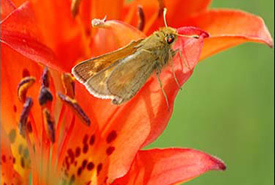
Dakota skipper (Photo by Phil Delphey/Wikimedia Commons)
Dakota skipper
Native to North America, Dakota skipper is part of the skipper family and gets its name from its unique “skipping” flight.
What does it look like?
Dakota skippers are a small prairie butterfly with a wingspan of 21 to 33 millimetres. The butterfly shares similar characteristics with other skippers, including a stout, short body and hooked antennae.
Male and female Dakota skippers vary in colour. The male’s upper wing surface ranges from orange to brown in colour, with a distinct dark brown mark on its forewing. The female’s dorsal wing surface is a darker brown with varying amounts of orange and characteristic pale spots on its forewing.
Where does it live?
In Canada, Dakota skippers can be found in southern Manitoba and southeastern Saskatchewan. The species is restricted to native prairie habitats, particularly tall grass. These prairies only exist in fragments and there are only a few fragmented populations of Dakota skipper left in Canada.
Dakota skippers are habitat specialists and are dependent on a variety of prairie-specific plants as they go through different developmental stages. Bluestem, a grass species, is abundant in tall and mixed-grass prairie and is one of the few prairie species the butterfly’s larvae relies on. Not only do the larvae rely on grasses for food, but they overwinter inside of silk shelters that they spin on grasses near ground level. In Manitoba, Dakota skippers consume nectar from harebell, black-eyed Susan, wood lily and mountain death camas flowers. In Saskatchewan, common gaillardia and narrowleaved prairie coneflower are important nectar sources. These plant species can act as indicators of the butterfly — if these flowers are in an area, it is likely that Dakota skippers may be found nearby.
What is this species' conservation status?
The Committee on the Status of Endangered Wildlife in Canada assessed the Dakota skipper as endangered. Historically, there has been widespread degradation and loss of prairie habitat that this species depends on. Pest control, overgrazing, encroachment of woody species and the continued conversion of habitats for other land uses are some of the factors currently contributing to the decline of this species.
What is NCC doing to protect habitat for this species?
The Nature Conservancy of Canada (NCC) is working to protect this species by conserving its habitats, including the Oak Lake Sandhills and Wetlands Natural Area, Interlake Natural Area and Tall Grass Prairie Natural Area in Manitoba. These areas support a diversity of wildlife and habitat types. The species occurs on NCC’s Oak Lake North property, where management is implemented to maintain and improve suitable prairie habitat through activities such as invasive species control. NCC is supporting research to better understand the status of the species and effectiveness of different management activities.





